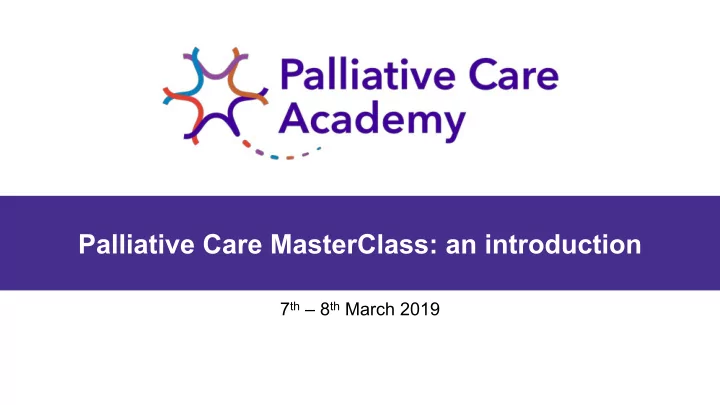

Palliative Care MasterClass: an introduction 7 th – 8 th March 2019
Demographics • This class of 27 is made of a mix of professionals. • 4 are specifically specialists in palliative or end of life care. • 10 are consultant level, • 5 registrars (5 of ST4 or above), • 5 are nurses (3 specialist) • 3 are AHPs: 1 specialist EoL OT and 1 pharmacist
Locations • 3 from Scotland • 1 from Wales 3 • 7 from the Northwest • 3 from the Northeast 3 • 7 from the Midlands 7 • 2 from London or Greater 7 1 London 3 • 4 from the Southwest 4
Needs analysis • Response rate of 23 out of 28 • Working in a range of settings: hospital based acute and community settings including: secondary care, including: • End of life care centre • acute frailty, • Hospice • In-patient care • Community palliative care • out-patient clinics • General practice
Time spent with Parkinson’s or dementia patients • 8 rated their contact as over 70% or as ‘majority’ of time • 2 rated their contact as regular: with 1-2 patients per day, and a weekly clinic respectively • 1 rated their contact as 50% • 6 rated their contact as 30% or below or as ‘variable’ and ‘not much’
Experience in patient palliative care ● 9 have direct, regular experience ○ work in palliative (4) or end of life care (1) ○ felt they had a strong knowledge or interest in palliative care (2) ● 6 have some experience with palliative care through current working ○ (mostly alongside people with a neurological condition). ● 5 had a reasonable level of knowledge if not experience, ○ training in palliative care (2), through routine general practice (1) or had regular involvement with those experiencing palliative care (1) ● 3 rated their involvement as little or occasional
Key wants and needs: overview • Improved understanding of pharmacological and non-pharmacological interventions • Improved knowledge and use of care planning in a number of forms • Improved knowledge of specific conditions, – including dementia, Parkinson’s, PSP and MS, and – improved management of symptoms during palliative and end of life phases • Better understanding of holistic or community-based palliative care, – inc spiritual and ethical elements of care, and when it is appropriate to consider elements of care • Improved communication with both patients and carers
Specific wants and needs: level 1 • Identify the end of someone’s life (n=4), inc through: – early recognition of the ‘dying phase’ – physiology and psychophysiology of the last days of someone’s life • Medical management, support (n=2) or possible interventions • Specific conditions (n=3) (Parkinson’s and dementia) • Communication with patients and families • Best practice in palliative care (n=3) inc: – the ‘scope’ of palliative care (n=1), – updated knowledge on different approaches (n=1) – personal improvement (n=1)
Specific wants and needs: level 2 • Pharmacological (n=4) and non-pharmacological (n=2) interventions, inc – difficulty swallowing (n=1) – meds management in Parkinson’s at the end of life (n=2) • Existing local service improvement (n=3) re – when to begin discussions or care planning (n=2), – how to integrate palliative care into existing services (n=1) – how to improve existing care dramatically (n=1). • Managing different symptoms at the end of life (n=1) or specifically in supporting those with a LTC (n=1) • Communication both with the patient or in support to family and carers.
Specific wants and needs: level 3 • End of life legislation (n=2) Practical use of advance care planning, care plans & emergency healthcare planning (n=2) • Challenges routinely faced at end of life (n=1) • Use of assessments (n=2) and cognitive screening (n=1) • Specific conditions (n=3) inc • Own / local services (n=3) re – MS – establishing community-based service – PSP, CBD / Parkinsonian conditions – holistic approaches – dementia via BPSD – ethical and spiritual considerations
Specific wants and needs: level 4 • Management at end of life (n=7) inc – pain – BPSD – spasticity – medication options for pain – meds management for Parkinson’s • Having positive, meaningful discussions with patients & families (n=3) • How do you define a ‘good’ death? • Exploring spirituality (n=1)
Specific wants and needs: level 5 • Support to family and carers (n=2), • Peer learning and interaction • Personal emotions and supporting colleagues in this • Deliver best possible care (n=3) inc – objective assessments – better judgements about services / individuals to involve when
What’s next? • INFO IN SLIDE HERE
Recommend
More recommend